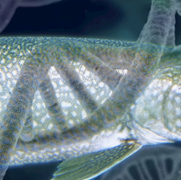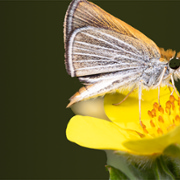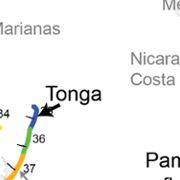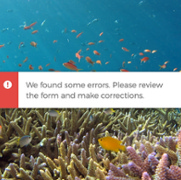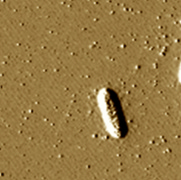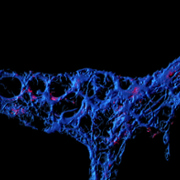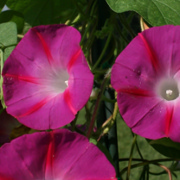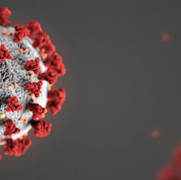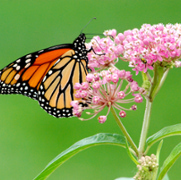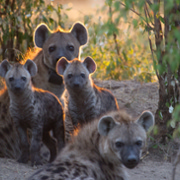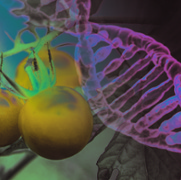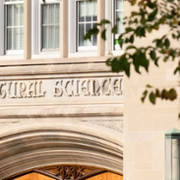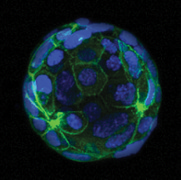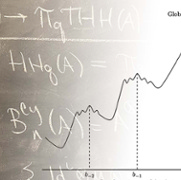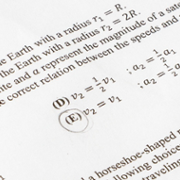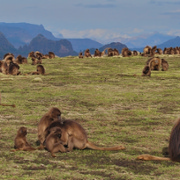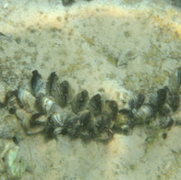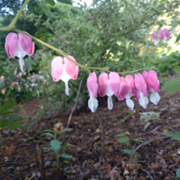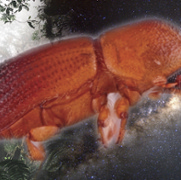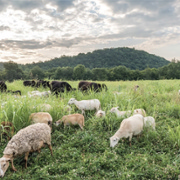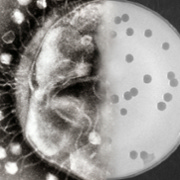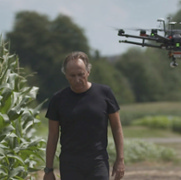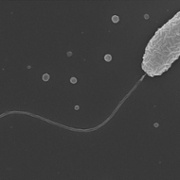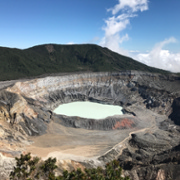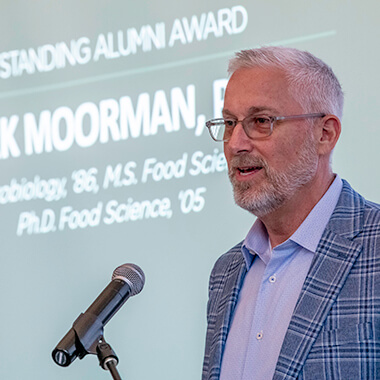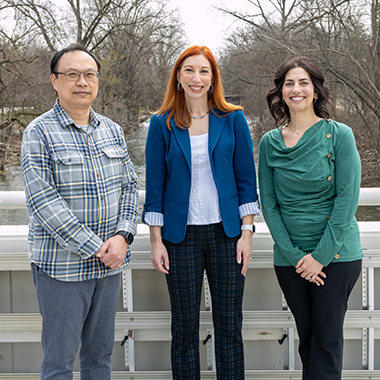News
August 24, 2021
Lake trout is an iconic native species to the Great Lakes. MSU integrative biology doctoral student Seth Smith is leading an effort along with his professor and an international team of researchers from the U.S. and Canada to create a reference genome for lake trout to support state and federal agencies with reintroduction and conservation efforts. The research from the team was published on Aug. 5 in the journal Molecular Ecology Resources.
August 18, 2021
With the help of a $500,000 grant from the United States Geological Survey (USGS) Midwest Climate Adaptation Science Center and 30 years of data, MSU quantitative ecologist Elise Zipkin and her multi-institution team will shed new light on the “Insect Apocalypse.” In a recent study, Zipkin developed a modeling strategy to analyze climate effects on monarch butterflies and found a strong correlation between temperature and precipitation in spring and summer breeding ranges and the subsequent size of the overall population. Motivated by these findings, her team is extending the models to other species.
August 16, 2021
MSU seismologist Songqiao “Shawn” Wei is the recipient of a $501,597 National Science Foundation Early CAREER Award to conduct a series of seismic attenuation studies on regional and global scales. These systematic investigations will potentially advance our understanding of seismic interpretation, upper-mantle dynamics, and material recycling in the Earth’s interior.
August 16, 2021
Missing metadata — data that provides information about other data — might not sound like a big deal, but it’s a costly problem that’s hindering humanity’s plans to protect the planet’s biodiversity. A Spartan-led research team reveals surprising gaps in ecological genetic data that could otherwise help global conservation efforts. MSU's Rachel Toczydlowski is the lead author of a new study in the journal Proceedings of the National Academy of Sciences, which features researchers from 14 institutions in three countries.The team audited the largest global repository for storing genetic sequence data to see if the entries included basic metadata needed to make them useful for monitoring genetic diversity.
August 11, 2021
For decades, scientists suspected that bacteria known as Geobacter could clean up radioactive uranium waste, but it wasn’t clear how the microbes did it. Now, MSU microbiologist Gemma Reguera and her team has the answer. Molecules called lipopolysaccharides coat the cell surface and soak up the uranium like a sponge. Their findings were recently published in the journal Applied and Environmental Microbiology.
August 9, 2021
Currently, there is no cure for Inflammatory Bowel Disease, or IBD, a condition that includes Crohn’s disease and ulcerative colitis. But new research led by MSU scientists is bringing fresh insight to the IBD table—an unexpected connection between specialized cells in the gut called glia and the genes involved in IBD. Their findings, published in Cellular and Molecular Gastroenterology and Hepatology, could lead to more effective treatments for one of the most elusive gut problems in the world.
August 5, 2021
A few years ago, Michigan State University quantitative ecologists Sarah Saunders and Elise Zipkin created a new statistical model to understand the threats endangered species face. Now, as federal agencies continue to use those findings, the research has earned this year’s Ecological Forecasting Outstanding Publication Award from the Ecological Society of America (ESA).
August 4, 2021
It was the beginning of the COVID pandemic and MSU plant biologist Emily Josephs could not go into her lab to work because of safety restrictions. So, she called up friend and colleague, Regina Baucom, from the University of Michigan, to see if she would be interested in collaborating virtually on an experimental evolution project using Baucom's existing system to study morning glory and Josephs' plant genomics data analysis expertise. The pair wanted to understand if a plant’s environmental response to stress is adaptive, or helpful to the plant. The results of this study were recently published in the journal Evolution Letters.
July 27, 2021
Researchers led by MSU’s Johannes Pollanen have developed a new device to help future quantum bits, or qubits (pronounced “Q bits”), take flight. Using liquid helium and readily available modern telecommunications technology —based on so-called “surface acoustic wave” devices — the Spartan team has created a new way to precisely manipulate electrons. With this capability, scientists can envision building what are known as trapped-electron quantum computers powered by processors whose quantum bits are free to move — or fly — around. The team showcased its new tech on July 6 in the journal Nature Communications.
July 26, 2021
While conducting outstanding research for capstone project honors, four MSU physiology undergraduate students found a blog to share their work sponsored by the American Physiological Society (APS) that focuses on the presence of physiology in everyday life for both scientists and non-scientists. Questions such as, what is physiology? where is physiology? and why does it matter to you? provide a focus for the APS I Spy Physiology Blog: Spotting Physiology in Everyday Life.
July 26, 2021
Bruce Uhal, MSU professor of physiology, is a leading expert on ACE-2, the main receptor, or docking molecule, for the SARS-CoV-2 virus that causes COVID-19 and is responsible for over half a million deaths in the United States. When SARS-CoV-2 began surging in 2020, Uhal joined an international group of scientists from India, Europe and the United States analyzing publicly available sequences of SARS-CoV-2 and ACE-2 to help track the origin and evolution of the virus and to develop targeted COVID-19 therapeutics.
July 21, 2021
MSU Distinguished Professor Kay Holekamp and her students have been observing hyenas as part of The Maasai Mara Hyena Project for over 30 years, following, tagging, sampling blood and feces, and amassing a rich dataset helping to answer questions previously thought impossible outside the lab. In a new study led by former postdoc Zachary Laubach, they found that less maternal care during the infant’s first year of life and less social connectedness once independent of the communal den are associated later in life with higher concentrations of stress hormones and less global DNA methylation. The exciting new study is published in Nature Communications.
July 19, 2021
MSU ecologists led an international research partnership of professional and volunteer scientists to reveal new insights into what’s driving the already-dwindling population of eastern monarch butterflies even lower. Between 2004 and 2018, changing climate at the monarch’s spring and summer breeding grounds has had the most significant impact on this declining population. In fact, the effects of climate change have been nearly seven times more significant than other contributors, such as habitat loss. The team published its report July 19 in the journal Nature Ecology & Evolution.
July 15, 2021
For the spotted hyena, a kind of inheritance that has nothing to do with genetics turns out to be extremely important for health and longevity—social networks inherited from their mothers. A new study, published in the journal Science and based on 27 years of observational data from Michigan State University Distinguished Professor Kay Holekamp, expands an established theoretical model of spotted hyena social networking to show how these networks emerge, how long they last and how they affect a hyena’s life trajectory.
July 13, 2021
We live in a time when it’s never been easier or less expensive to sequence a plant’s complete genome. But knowing all of a plant’s genes is not the same thing as knowing what all those genes do. MSU experts in plant biology and computer science plan to close that gap with the help of artificial intelligence and a new $1.4 million NSF grant. Ultimately, the goal is to help farmers grow crops with genes that give their plants the best chance to withstand threats such as drought and disease.
July 13, 2021
Toxoplasma gondii is a single-celled parasite with a singular goal: to infect any warm-blooded animal until it is ingested by a wild or domestic cat. Using the strength of interdisciplinary collaboration, MSU scientists have conducted a first-of-its-kind study into the role of T. gondii in the wild, establishing its definitive presence and influence among free-living hyenas. Their results were recently published in Nature Communications.
July 9, 2021
Geoscience organizations play a central role in shaping the discipline by influencing attitudes, setting standards and providing benefits to their members. Although many organizations within the geoscience community have released statements calling out societal racism and discrimination, geoscience remains one of the least diverse fields among science and engineering. To address this issue, geosciences researchers from all over the country, including Michigan State University’s Julie Libarkin, recently published a ground-breaking Perspectives article in the journal Nature Communications recommending specific antiracism action steps for the geoscience field.
July 7, 2021
Five years ago, researchers at Northwestern University made international headlines when they discovered that human eggs, when fertilized by sperm, release billions of zinc ions, dubbed “zinc sparks.” Now, Northwestern has teamed up with the U.S. Department of Energy’s Argonne National Laboratory and Michigan State University to reveal that these same sparks fly from highly specialized metal-loaded compartments at the egg surface when frog eggs are fertilized. The findings of the research, which could help shape future findings about how metals impact the earliest moments in human development were recently published June 21 in the journal Nature Chemistry.
July 6, 2021
Four MSU College of Natural Science faculty members – Federica Brandizzi, Joseph S. Krajcik, Robert L. Last, and Kenneth M. Merz, were among 11 MSU faculty members named University Distinguished Professors this year by the MSU Board of Trustees in honor of their achievements in research, teaching and mentoring, and community engagement. Being named a University Distinguished Professor is one of the highest honors that can be bestowed on a faculty member by the university.
July 6, 2021
Dr. Esther M. Brown, a great champion and catalyst for the Biomedical Laboratory Program, Michigan State University and the entire laboratory profession, died on June 23. She was 98 years old. Dr. Brown was director of the program at MSU from 1960-1970 and a pioneer and trailblazer for women in STEM fields at the time. Dr. Brown shaped many lives and was a true giant in the medical laboratory profession.
July 1, 2021
Spartan researchers, led by MSU's Amy Ralston, introduce a new fluorescent imaging technique dubbed GOGREEN that will help researchers study developing mouse embryos faster and more efficiently. Their work was recently published online in the journal Development.
June 30, 2021
MSU is two for two in 2021 when it comes to the National Science Foundation’s highly competitive Focused Research Group grant. MSU mathematicians Teena Gerhardt and Ilya Kachkovskiy, in collaboration with principal investigators from institutions across the country, will use the 3-year grants to advance research in some of the most exciting questions in topology, geometry and mathematical analysis.
June 29, 2021
The physics Graduate Record Examination (GRE) costs just over $200, is administered early Saturday morning and requires the prospective student to answer 100 rapid fire questions in just three hours. According to the physics GRE website, doing well on the test will help students stand out like a diamond in the rough among the thousands of other applications being sifted through admissions committees. But newly published research by MSU scientists concluded that rather than helping, taking the physics GRE could actually harm a student’s chances of admission.
June 29, 2021
Michigan State University statistician Frederi Viens is one of a select group of 23 scholars worldwide who have achieved what has been dubbed the Institute of Mathematical Statistics (IMS) Annals quadfecta. The IMS publishes four flagship "Annals" research journals, considered to be top periodicals in each of their respective subfields. The notion of the Annals quadfecta came about when a two-person team at the University of Toronto wondered which authors had accomplished the feat of publishing at least one paper in all four of these journals.
June 27, 2021
Michigan State University-led research is showing how social dynamics can help us understand behaviors in geladas (a monkey species) and other primates, including humans. MSU integrative biologist Elizabeth Tinsley Johnson and collaborators at the University of Michigan, Arizona State University and Stony Brook University in New York, have studied geladas in Ethiopia’s Simien Mountain National Park for 14 years to look for answers. Their findings were published earlier this month in the journal, Proceedings of the Royal Society B.
June 24, 2021
While invasive zebra mussels consume small plant-like organisms called phytoplankton, MSU researchers Stephen Hamilton and Orlando Sarnelle discovered during a long-term study that zebra mussels can actually increase Microcystis, a type of phytoplankton known as “blue-green algae” or cyanobacteria, that forms harmful floating blooms. The study, titled Cascading effects: Insights from the U.S. Long Term Ecological Research Network, is one of five projects recently highlighted in a special feature in the Ecological Society of America’s journal, Ecosphere.
June 18, 2021
MSU Foundation Professor Beronda Montgomery has been named a 2021 Fellow of the American Society of Plant Biologists (ASPB). Montgomery is being recognized for her distinguished and long-term contributions to plant biology and service to the society.
June 16, 2021
The original Star Trek television series took place in a future when space is the final frontier, but humanity hasn’t reached that point quite yet. As researchers like MSU entomologists Sarah Smith and Anthony Cognato are reminding us, there’s still plenty to discover right here on Earth. Working in Central and South America, the duo discovered more than three dozen species of ambrosia beetles — beetles that eat ambrosia fungus — previously unknown to science. Smith and Cognato described these new species on June 16 in the journal ZooKeys and named some after iconic sci-fi heroines.
June 15, 2021
In an exciting collaboration between MSU's Bruno Basso and Skidmore College's Kristofer Covey, farmers in the United States will have an opportunity to cultivate a sustainable future for themselves and the planet with MySOC, a platform that measures soil carbon through app-led field methods, sophisticated remote sensing technology and biophysical modelling recently awarded a $250,000 prize from the Morgan Stanley Institute for Sustainable Solutions Collaborative.
June 14, 2021
Developing improved materials for things such as energy storage and drug discovery is of interest to researchers and society alike. Quantum mechanics (QM) is the basis for molecular and materials scientists who develop these useful, futuristic products. The challenge is that the QM calculations to describe the many properties of molecules and the materials they make up require a lot of computer power. To address this issue, a small team of postdoctoral scholars led by MSU’s Kenneth Merz, and University of California, San Diego’s Andreas Goetz developed software that takes advantage of powerful graphics processing units, or GPUs, for these complex QM calculations of molecules.
June 10, 2021
A champion team of three math instructors—Michael Brown, Math 102 supervisor; Rachael Lund, Math 101 supervisor, and Shiv Karunakaran, assistant professor of mathematics education at —assembled the summer before students virtually arrived in Fall 2020 with plans to design a new online platform for Math 101/102. COVID forced their plans into action sooner than anticipated. The quantitative literacy courses rolled out to more than 1,600 students that fall semester—just in the nick of time.
June 7, 2021
Kristin Parent, J.K. Billman, Jr., M.D. Endowed Research Professor at MSU, is lead investigator on a $1.5 million National Institutes of Health (NIH) Maximizing Investigator’s Research Award (MIRA). Her pioneering research utilizes basic microbiology and cutting-edge cryo-microscopy to investigate, at the near atomic level, how viruses known as bacteriophage, or phage, use cell surface proteins to connect to, infect and reproduce inside some of the world’s deadliest gut bacteria—bacteria such as Salmonella, E. coli and Shigella—destroying them in the process.
June 3, 2021
Bruno Basso, a Michigan State University Foundation Professor in the Department of Earth and Environmental Sciences in the MSU College of Natural Science and a W.K. Kellogg Biological Station faculty member, shares his thoughts on agricultural systems and feeding the future sustainably. Basso’s research broadly deals with sustainable agriculture. His main focus is on water, carbon, nitrogen cycling and modeling in agro-ecosystems, and spatial analysis of crop yield.
May 27, 2021
MSU microbiologist Chris Waters is using a five-year, $2.62 million National Institutes of Health MIRA grant to explore questions on the diversity of a class of signaling molecules known as cyclic di-nucleotides, or cdN. Since cdNs are critical for bacteria to cause disease as well as immune regulation in humans, understanding how they function can lead to new strategies to manipulate these systems for therapeutic treatments.
May 26, 2021
MSU researchers, including geomicrobiologist Matthew Schrenk, joined an interdisciplinary and international team of scientists who have revealed how ‘forests’ of microbes living in geological hotspots play an underestimated role in Earth’s carbon cycle.
May 25, 2021
Jabbar Bennett, Michigan State University vice president and chief diversity officer, was interviewed as part of a special section published May 22 in the Lansing State Journal on what’s changed in the year following George Floyd’s murder.
